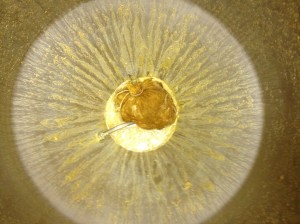The experimental hop fairy visited my house again recently, and this time it’ll be a lavishly alphanumeric best bitter type of deal. Continue reading
Category Archives: hops
I kegged an IPA today, oh boy
It was a lucky ale with EXP 5256; and though the beer was rather flat, I still had a draft. I took this photograph.
Polaris, polarization
The recent brew day with its test-drive of Polaris – and subsequent comments from several of you citizens – got me thinking about hop varieties that don’t have a gray area between love and hate. Continue reading
QPA: update
Since we last talked about it, the main batch of Quotidian Pale Ale has been brewed, fermented, dry-hopped, and very recently packaged. What we’re looking at here is a glass of the little one gallon pilot/yeast starter. Continue reading
the alchemy of FWH
“Despite increased bitterness, the tasting panel described the first wort-hopped beers as more pleasant tasting and overwhelmingly preferred them. Gas chromatographic analysis indicated the conventionally hopped beers contained a higher level of hop aroma substances … but panelists nonetheless described the first wort-hopped beers as having a very fine and rounded hop aroma and rounded hop flavor.”
Stan Hieronymous, For the Love of Hops
Hack & Slash XPA: Mosaic Edition
Here it is, the promised follow-up on the brew day with Jake Keeler and the artist formerly known as HBC 369. Continue reading
on Minnesota hops
A reader posted this question to the “About” page of this blog:
I’m curious about your thoughts of the hops industry, or lack thereof in MN. It seems that there are breweries opening every month, but virtually no one in MN is growing hops at even a semi-commercial scale. Do you think this is a needed industry in MN, and do you think that the local brewers would prefer to brew with locally sourced hops?
… and as I’ve written and rewritten my thoughts on this, the response turned into something that needed more than a one-paragraph reply to a thread on a different topic. Continue reading
flavor installation in your mouth gallery
Just a peach of a brew session today with Mr. Jake Keeler, and the boiler is soaking in the PBW as I type. Writeup and tasting notes to follow, but first a word about our first time out with Mosaic hops:
They’re real nice. Continue reading
lessons in patience, part 1
Point: when it comes to good beer, freshness counts for a lot.
Counterpoint: most homebrewers (myself included) “release” their beer before its peak. Continue reading
nothing new under the sun
One of the great things about a fiber-rich diet is that it affords daddy some quality reading time in his special office, and this morning some muesli induced me to finally start digging in to Mitch Steele’s IPA (that’s an acronym for something, but I’m not far enough along in the book) and came across this nugget regarding (probable) brewing practices for the nascent style in the 18th century:
Hops were added during the boil and were often only allowed to boil for 30 minutes before being pulled out and replaced with another charge. It is cited in many brewing texts of the period that brewers believed that boiling hops for more than 30 minutes extracted rough and harsh flavors and bitterness.
Kind of a philosophical antecedent to the whole late-addition and hopbursting approach – not directly analogous and probably with not quite the same results in the kettle, but still predating the 21st century craft brewing “hoppy not bitter” mantra by a good 250 years. Nothing new under the sun.
Also:
Occasionally hair sieves were used to strain the hops from the wort.
Maybe there’s a market for follicle-based hop-separation technology in modern home- and craft brewing? Somebody try that out, let me know how it goes.






